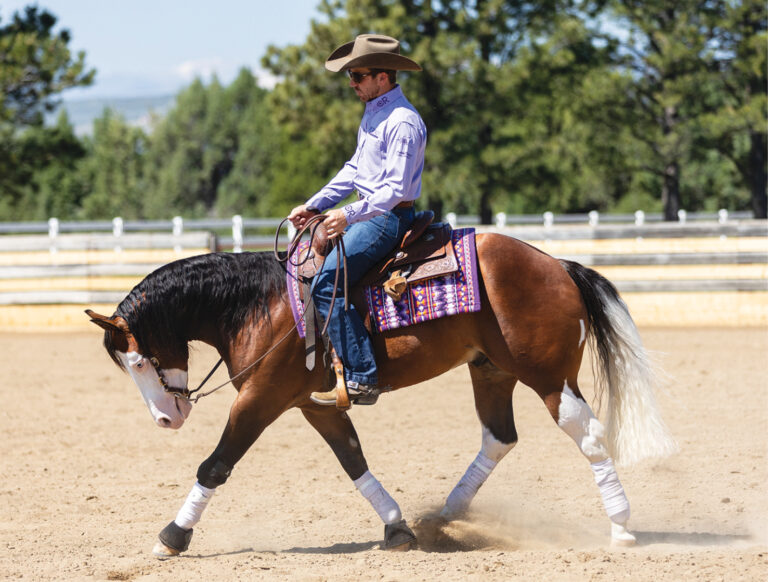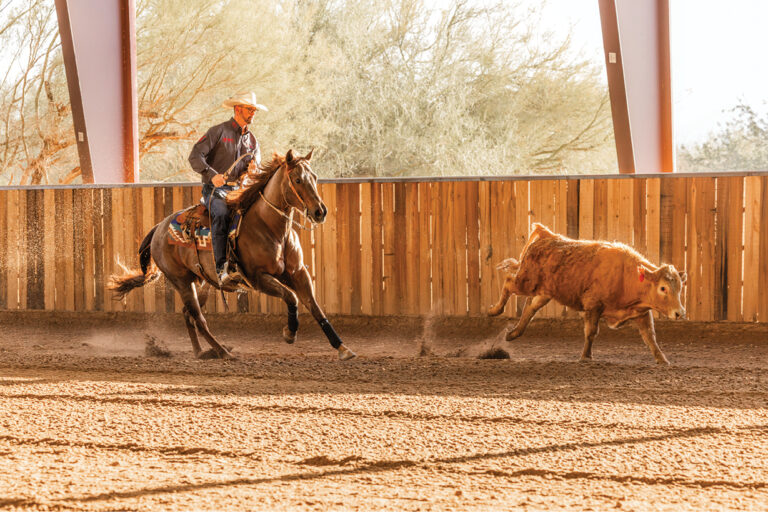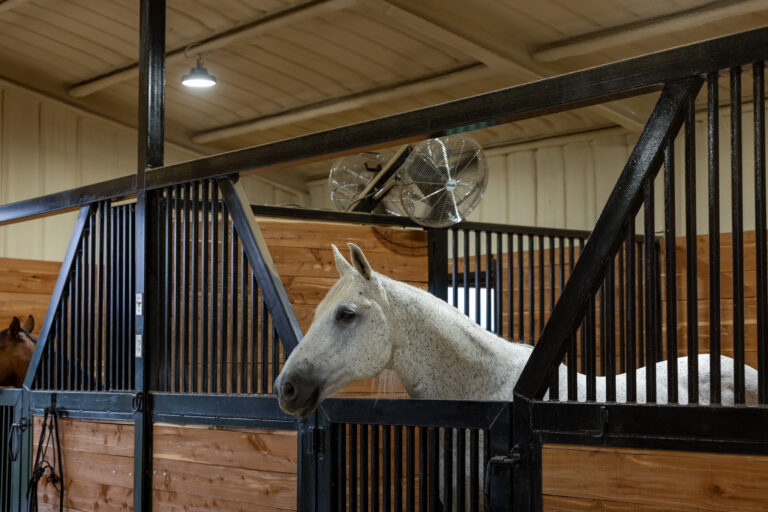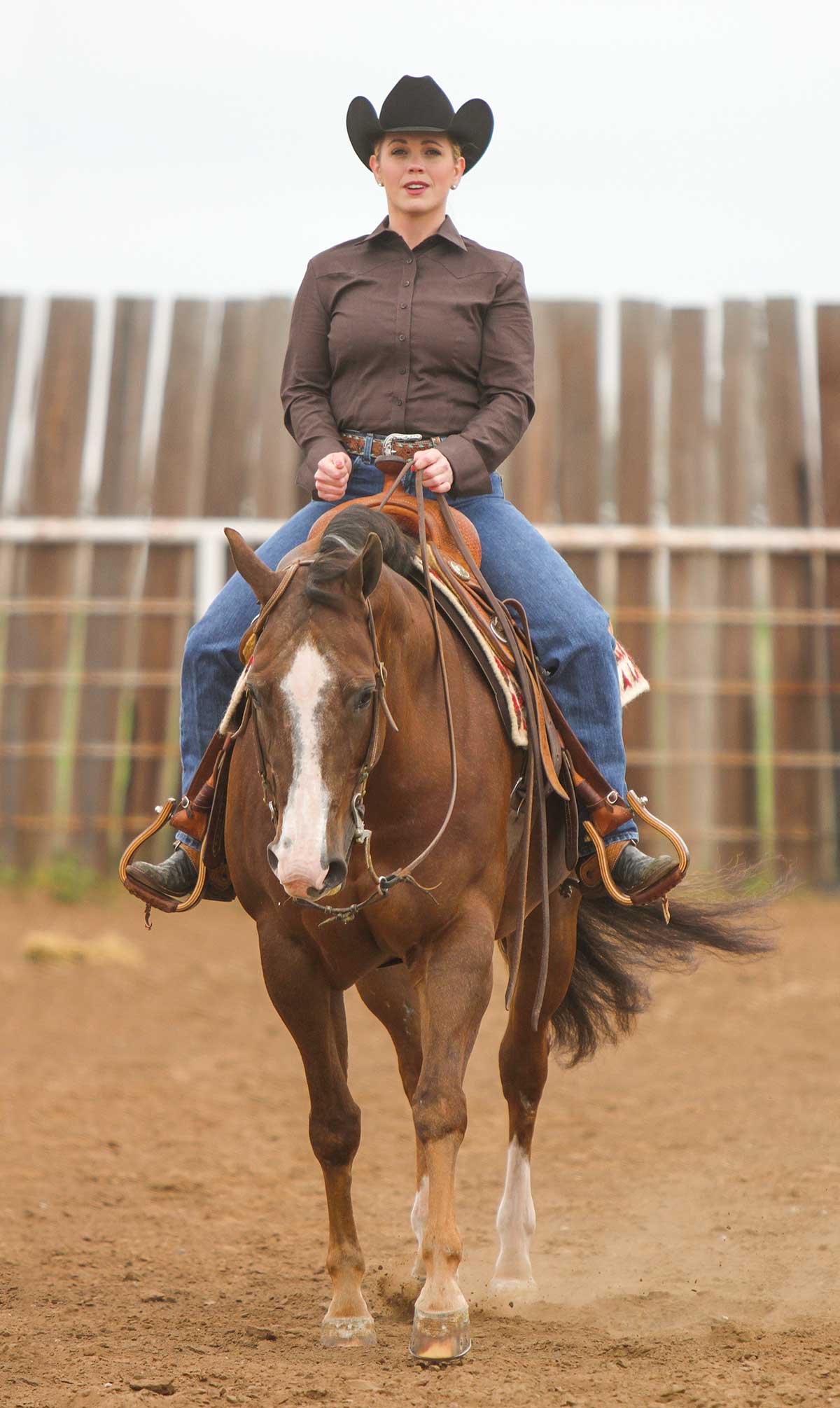
It’s comfy on the rail. You have a clear direction, and you can almost go on autopilot. Your horse can, too. But spending the majority of your time riding on the rail will create future problems for you and your horse. The path to success—whether in the show pen or in your personal riding—doesn’t go through your comfort zone.
Changing up your riding routine helps you improve as a rider and builds your horse’s stamina and strength. It can even open the door to trying new events if you build confidence away from the wall.
Here I’m going to explain what problems you and your horse might experience when you stay on the wall for too long, and offer exercises you can practice to boost your confidence, and get comfortable steering and moving your horse’s body around in the middle of the arena.
[MORE CONFIDENCE: CONTROL YOUR HORSE’S FEET]
Forming Bad Habits
You don’t have to show in a rail class to become dependent on the wall. Maybe in the past you’ve had a bad experience with a nervous horse and now lack confidence in the middle of the pen. Or you’re still new to riding and don’t know what exercises to work on when you’re riding by yourself. There are many reasons you’d like to stick close to the rail, but what you don’t see are the bad habits it creates for both you and your horse. And the longer you let these habits go, the harder they are to break.
If you’re uncomfortable taking a hold of your horse and moving his body around, or even just steering him, it probably means you’re letting him go around on a draped rein, with no leg contact, and you’re not requiring him to drive forward with his hind end. Eventually, he’ll go into auto-pilot and start ignoring any cues from you because he’s become so accustomed to doing what he wants on the wall.
Furthermore, your horse can’t physically stay fit if you live on the rail, as you’re limited to straight lines. He’ll start to hollow out his body and even trope (a trot-lope combination with four beats instead of the lope’s three beats) because he’s not strong enough to carry himself. While being able to ride straight is important, your horse must be comfortable moving his body around and achieve suppleness and softness when you go to your hand and leg.
The One Time to Stay on the RailWhen you compete in rail events, the only time you go to the middle of the arena is at the end of the class to line up for results. Eventually, your horse will associate going to the middle as signal that his job is done, so he’ll anticipate walking to the center of the pen
Riding in the middle of the arena during your practices can improve your rail performance, because your horse isn’t in a rush to get to the middle of the arena. He starts to associate that space with work rather than a break. He might even become more relaxed when you’re in the show pen. After you’ve completed your ride for the day, have him sit on the rail for a few minutes and relax. This way he’ll start to associate the rail as a place where he can relax.
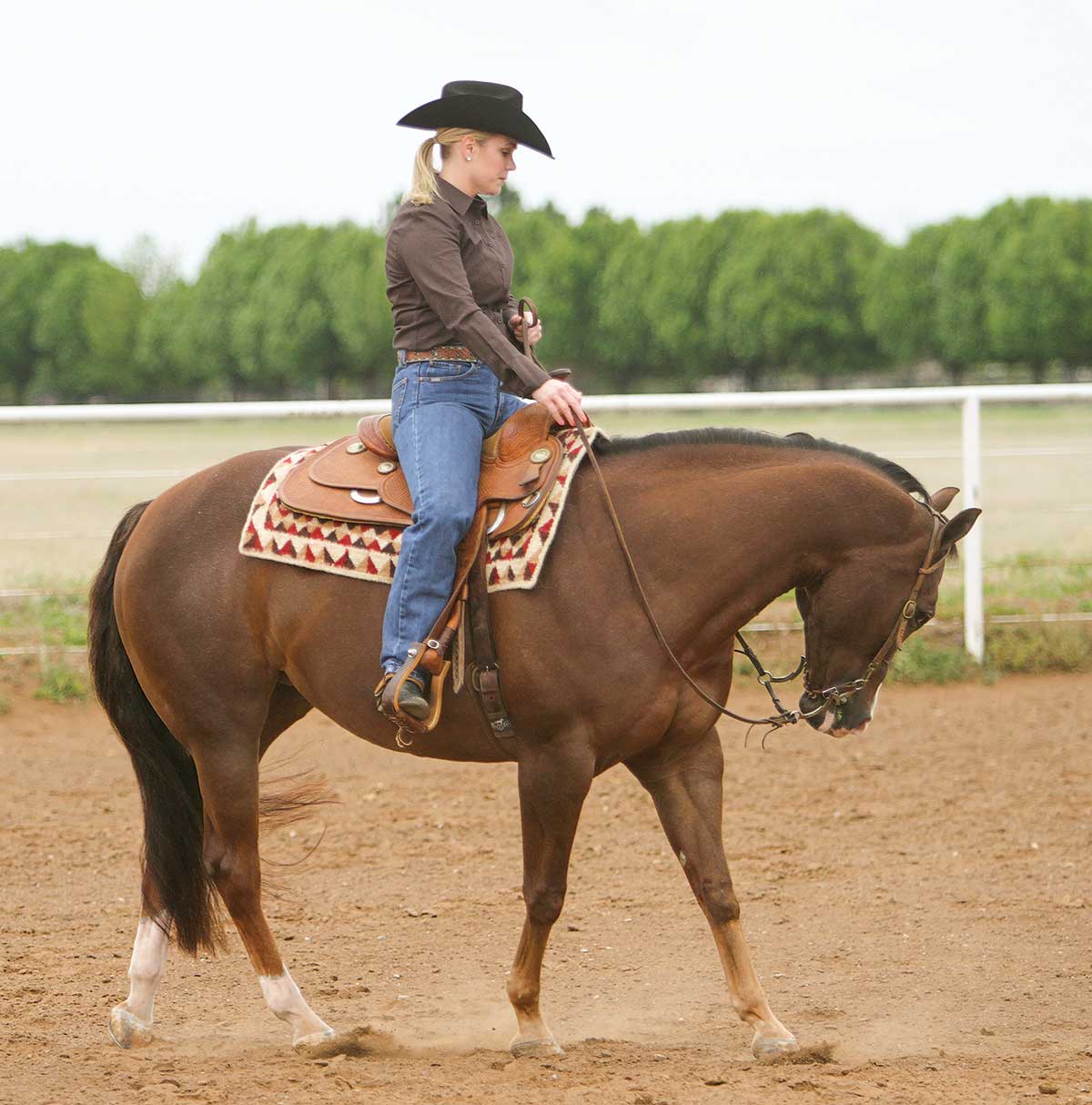
Exercises to Get Off the Wall
It doesn’t matter if you’re riding for fun or you compete, you need to be able to move your horse around and make sure he’s comfortable when you use your hand and leg cues. These exercises will help you gain control over where your horse puts his body. If you have control, you’ll be able to easily steer him anywhere in the pen, and keep his body rounded at each gait.
Start in a snaffle bit, riding two-handed. The point is to ride your horse in something that won’t intimidate him, but also a bit that won’t let him get away from you while you’re working on your lateral movements. As you advance in these exercises, you can move to a curb bit, but continue to ride two-handed to get the best results.
Start on a large circle at the walk. Once you’re comfortable completing the following exercises at the walk, increase the difficulty by trotting. It’s best to have the whole arena to yourself—or at least not a crowded riding area. You don’t want to overwhelm your horse by trying to steer around traffic while introducing unfamiliar exercises to your riding routine.
It takes time to stop being the passenger and become the rider; you might not even get to all of these exercises in one ride. Take your time when you start adding these drills to your riding routine. Teaching your horse how to properly use his body will take time, and he won’t become supple overnight. If you feel you’ve made progress, end your ride for the day, or work on something else; don’t mentally work your horse (or yourself) to the point of frustration.
These will become your go-to warm-up tools, as they are also designed to continuously improve your horse’s strength and stamina.
[MORE CONFIDENCE: CONFIDENT TRANSITIONS]
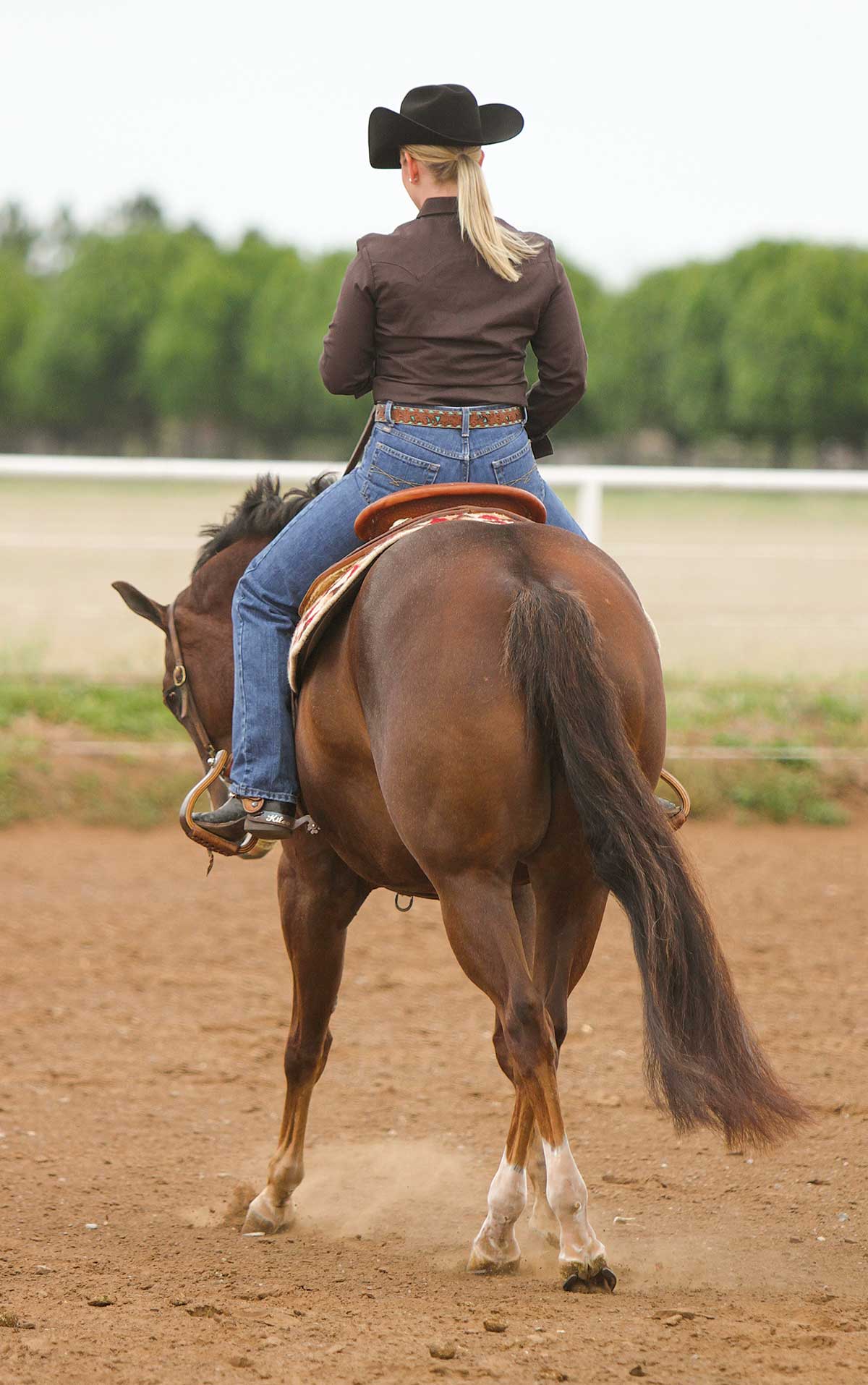
Counter-arc. Improve your horse’s cadence and soften his rib cage and shoulders with a counter-arc (above). Stay on your circle and at a walk or a trot, take your horse’s head to the outside, and use your outside leg to move his ribcage in. Move your inside leg away from your horse so his rib cage has somewhere to go. Remember to use both hands to hold up his shoulder as you push his ribcage. Practice counter-arcing your horse both directions, so he’s supple on both sides of his body.
Key tip: It’ll take your horse a few weeks to supple up from this exercise, so don’t put too much pressure on him at the beginning. Once you feel you’ve made some progress, go to another exercise and come back to this one the next time you ride.
Leg yield. The leg yield is designed to help improve your horse’s flexibility, and is also a great way to teach your horse self carriage (above). Think of this lateral movement as a sidepass with forward motion. To go to the left, tilt your horse’s nose slightly to the right, but keep steady contact with both reins to help his shoulders stand up. Use your right leg to push over his hip and rib cage. Don’t lose impulsion when you ask for him to leg yield; use your left leg to maintain a cadenced forward gait as he crosses his legs. This exercise not only promotes suppleness, cadence, and balance, it’ll also help your horse get off your leg if he leans or is heavy on one side.
Key tip: As you begin to leg-yield or two-track your horse, stay balanced in your saddle and feel where his legs are. Don’t get lazy and lean away from your direction of travel. Your horse should cross his hind legs and his front legs over one another as you walk or trot.
Back a square. If your horse is heavy on his front end rather than driving from his hind end, it’ll take effort on your part to break that habit and build up his muscle so he can properly drive from behind. Backing your horse in a square is a great way to help build his muscle.
Start at a trot; have a steady, two-beat rhythm going. When you feel your horse start to fall forward and get strung out in his trot, immediately stop and back. You want him to rock back and use his hind end. Once you’re comfortable backing for more than a few steps, go into backing a square corner.
Start by backing six steps. Keep your horse’s body straight until you want to turn the corner; you don’t want to back a circle. To turn the corner, push your horse’s hip over with your outside leg, and use your inside rein to keep his inside shoulder from diving in. Leave your inside leg close to your horse so he doesn’t lean his ribs into the 90-degree turn. You want him to stay standing up and under himself as he performs the corner. Once you finish your corner, go back to even rein and leg pressure to keep his body straight until you ask for the next turn. This will help your horse build muscle, and lift his back and remain lifted while giving you more control over your horse’s hips and where he moves them.
Key tip: Start this exercise by attempting one or two square corners. As your horse gets stronger in his back end, build up to a full square.

Straight lines. After you’ve mastered the previous exercises, and you’re comfortable using your hands and legs, try to master a straight line away from the rail. Go to the middle of one end of your arena. Pick up a trot, and go straight to the other end. Guide with your hands and legs to stay on a straight line.
Once you’ve mastered trotting a straight line from one end of the arena to the other, increase the difficulty by doing the same thing at the lope. Make sure that when you’re loping, your horse is cadenced and stays rounded up and underneath himself. Remember to keep him driving from behind; if you feel like you’ve lost cadence and you can’t get him to round back up, go back to your previous drills.
Key tip: To help you stay straight, and avoid drifting to one side of the arena, keep your eyes up, and look where you want to go.
Wes Wetherell, Purcell, Oklahoma, trains Western pleasure, all-around, and young show prospects. He’s been training horses professionally for 33 years and has produced multiple world and Congress champions in several breed associations. Learn more at weswetherell
quarterhorses.com.

